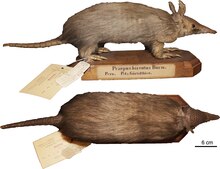| Hairy long-nosed armadillo | |
|---|---|

| |
| Conservation status | |
 Data Deficient (IUCN 3.1) | |
| Scientific classification | |
| Domain: | Eukaryota |
| Kingdom: | Animalia |
| Phylum: | Chordata |
| Class: | Mammalia |
| Order: | Cingulata |
| Family: | Dasypodidae |
| Genus: | Dasypus |
| Species: | D. pilosus |
| Binomial name | |
| Dasypus pilosus (Fitzinger, 1856) | |

| |
| Hairy long-nosed armadillo range | |
| Synonyms | |
| |

The hairy long-nosed armadillo or woolly armadillo (Dasypus pilosus) is a species of armadillo in the family Dasypodidae. It is endemic to Peru. Its natural habitats are subtropical or tropical moist lowland forest and subtropical or tropical moist montane forest. The International Union for Conservation of Nature used to consider it a "vulnerable species" but has changed this assessment to "data deficient" because so little is known about the animal and the threats it faces.
Description
The hairy long-nosed armadillo is poorly known. Like other species of Dasypus, it has a hard armour-like shell, called a carapace. The armour consists of ossified dermal plates composed of a number of movable bands covered by leathery skin. The rostrum is long and slender and is more than half the length of the head. There are long, hairless ears and a slender tail, tapering to a point. The front part of the tail is protected by keratinised rings of scales. The front feet have four strong claws and the hind feet five. It has a distinctive coat of long reddish-brown or grayish-brown fur which grows through tiny pores in its armour. It has similar bodily proportions to other armadillos but is unlikely to be confused with any other species. One male individual studied had a total length of 575 mm (23 in) including a tail of 252 mm (10 in).
Distribution and habitat
This armadillo is endemic to Peru, where it is found on the eastern side of the Andes Mountains. It is present in the regions of San Martín, where it is present in the Rio Abiseo National Park, La Libertad, Huánuco and Junín and has also been reported from the region of Amazonas. Its habitat is the Yungas, a stretch of subtropical, deciduous and evergreen forests along the eastern slopes of the mountains. It seems to frequent dense undergrowth in limestone areas.
References
- Gardner, A.L. (2005). "Order Cingulata". In Wilson, D.E.; Reeder, D.M (eds.). Mammal Species of the World: A Taxonomic and Geographic Reference (3rd ed.). Johns Hopkins University Press. p. 95. ISBN 978-0-8018-8221-0. OCLC 62265494.
- ^ Superina, M.; Abba, A.M. (2014). "Dasypus pilosus". IUCN Red List of Threatened Species. 2014: e.T6291A47441122. doi:10.2305/IUCN.UK.2014-1.RLTS.T6291A47441122.en. Retrieved 17 November 2021.
- Gardner AL 2007 - Mammals of South America Vol 1: Marsupials, Xenarthrans, Shrews and Bats - University of Chicago Press, Chicago.
- ^ Gardner, Alfred L. (2008). Mammals of South America, Volume 1: Marsupials, Xenarthrans, Shrews, and Bats. University of Chicago Press. pp. 130, 137. ISBN 978-0-226-28242-8.
- Eisenberg, John F.; Redford, Kent H. (2000). Mammals of the Neotropics, Volume 3: Ecuador, Bolivia, Brazil. University of Chicago Press. p. 105. ISBN 978-0-226-19542-1.
| Taxon identifiers | |
|---|---|
| Dasypus pilosus | |
| Cryptophractus pilosus | |